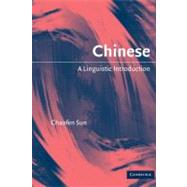
Note: Supplemental materials are not guaranteed with Rental or Used book purchases.
Purchase Benefits
Looking to rent a book? Rent Chinese: A Linguistic Introduction [ISBN: 9780521530828] for the semester, quarter, and short term or search our site for other textbooks by Chaofen Sun. Renting a textbook can save you up to 90% from the cost of buying.
| List of maps | viii | ||||
| List of tables | ix | ||||
| List of figures | x | ||||
| Preface | xi | ||||
| Major chronological divisions of Chinese history | xiii | ||||
| Major periods of the Chinese language | xiv | ||||
| Introduction | 1 | (12) | |||
| 1 Historical background of the language | 13 | (21) | |||
|
13 | (1) | |||
|
14 | (1) | |||
|
15 | (2) | |||
|
17 | (1) | |||
|
18 | (2) | |||
|
20 | (3) | |||
|
23 | (3) | |||
|
26 | (2) | |||
|
28 | (6) | |||
|
29 | (1) | |||
|
30 | (4) | |||
| 2 Phonetics of standard Chinese | 34 | (11) | |||
|
35 | (1) | |||
|
36 | (2) | |||
|
37 | (1) | |||
|
37 | (1) | |||
|
38 | (1) | |||
|
38 | (1) | |||
|
39 | (1) | |||
|
40 | (5) | |||
| 3 Chinese morphology 1 | 45 | (30) | |||
|
49 | (7) | |||
|
56 | (8) | |||
|
56 | (2) | |||
|
58 | (2) | |||
|
60 | (4) | |||
|
64 | (9) | |||
|
64 | (4) | |||
|
68 | (2) | |||
|
70 | (3) | |||
|
73 | (2) | |||
| 4 Chinese morphology 2 | 75 | (26) | |||
|
75 | (13) | |||
|
75 | (6) | |||
|
81 | (7) | |||
|
88 | (7) | |||
|
88 | (1) | |||
|
89 | (1) | |||
|
90 | (2) | |||
|
92 | (3) | |||
|
95 | (4) | |||
|
99 | (2) | |||
| 5 Chinese writing | 101 | (14) | |||
|
101 | (2) | |||
|
103 | (4) | |||
|
107 | (3) | |||
|
110 | (5) | |||
| 6 Chinese language and culture | 115 | (32) | |||
|
116 | (17) | |||
|
116 | (6) | |||
|
122 | (4) | |||
|
126 | (7) | |||
|
133 | (8) | |||
|
141 | (4) | |||
|
145 | (2) | |||
| 7 Chinese syntax 1 | 147 | (37) | |||
|
148 | (5) | |||
|
153 | (5) | |||
|
158 | (6) | |||
|
164 | (2) | |||
|
166 | (4) | |||
|
170 | (2) | |||
|
172 | (12) | |||
|
172 | (9) | |||
|
181 | (3) | |||
| 8 Chinese syntax 2 | 184 | (36) | |||
|
186 | (2) | |||
|
188 | (1) | |||
|
189 | (2) | |||
|
191 | (9) | |||
|
191 | (6) | |||
|
197 | (3) | |||
|
200 | (6) | |||
|
200 | (5) | |||
|
205 | (1) | |||
|
206 | (12) | |||
|
206 | (3) | |||
|
209 | (9) | |||
|
209 | (2) | |||
|
211 | (1) | |||
|
212 | (6) | |||
|
218 | (2) | |||
| Appendix 1 Phonetic symbols | 220 | (3) | |||
| Appendix 2 Capitalized abbreviations | 223 | (2) | |||
| References | 225 | (4) | |||
| Index | 229 |
The New copy of this book will include any supplemental materials advertised. Please check the title of the book to determine if it should include any access cards, study guides, lab manuals, CDs, etc.
The Used, Rental and eBook copies of this book are not guaranteed to include any supplemental materials. Typically, only the book itself is included. This is true even if the title states it includes any access cards, study guides, lab manuals, CDs, etc.